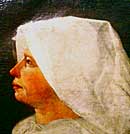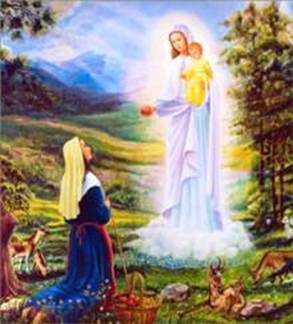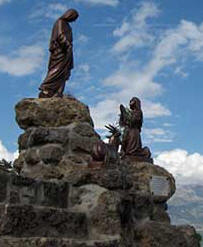|
 Her
Life After Death --
video
An in-depth interview with
Sondra Abrahams asking provocative and thought provoking questions about Heaven,
Hell and Purgatory. You'll also hear about guardian angels and encounters
with deceased friends and relatives. It provides astonishing evidence that
death is only the beginning... (bestseller)
CLICK HERE Her
Life After Death --
video
An in-depth interview with
Sondra Abrahams asking provocative and thought provoking questions about Heaven,
Hell and Purgatory. You'll also hear about guardian angels and encounters
with deceased friends and relatives. It provides astonishing evidence that
death is only the beginning... (bestseller)
CLICK HERE
|
|
|
|
|

__________________________________________________
APPROVED APPARITION ACCENTS 'ODOR OF
SANCTITY' AND OPENS MYSTICAL TREASURE
By Michael H. Brown
 The
apparition approved Sunday by the Church in dramatic style in France opens a veritable treasure trove of mysticism.
The
apparition approved Sunday by the Church in dramatic style in France opens a veritable treasure trove of mysticism.
Involving
a young woman named Benoîte Rencurel in the diocese of Gap, the
apparitions, visions, and other manifestations at Notre Dame du Laus lasted her lifetime
and now bring to light a major new mystic who -- in addition to
experiencing what are now approved apparitions -- displayed
supernatural abilities and such piety that she was
named venerable more than a century ago and may now be headed for full canonization.
As in many instances, the
visionary's phenomena were inextricably attached to the apparitions
themselves, blurring the line between mystic and seer.
That phenomena included stigmata
(the wounds of Christ), uncanny knowledge of the future, the ability to
read souls, battles with the devil, and angelic interventions, especially
of the Archangel Michael.
Perhaps most poignant in the
remarkable account of this apparition -- which spanned from 1664 until
1718 and will become known as "Laus"
(pronounced lou, after the valley in which the visions occurred) -- are
accounts describing the huge and perhaps unprecedented manifestations of
delicious heavenly aromas known to mystical theologians as the "odor of sanctity."
The aroma, often recounted as a
cross between lilies and roses -- but yet more delightful -- lasted for
weeks at a time and covered large outdoor areas.
Noted one official, a judge named
François Grimaud: "During the Easter Season of 1666, I smelled a very
sweet fragrance for around seven minutes; I had never smelled anything
like it in my life, and it gave me such deep satisfaction that I was
enraptured." The odor continued beyond the seer's death and is still in
evidence.
According to one account, it was so powerful in the spring of 1690 that the Laus church was pervaded with the fragrance
and "all the
pilgrims attested to it."
 To
this day, inexplicable such aromas are said to transcend even the
delightful natural scents of flowers and other flora that make this spot
seem as if it was pre-ordained to be a major spiritual refuge.
To
this day, inexplicable such aromas are said to transcend even the
delightful natural scents of flowers and other flora that make this spot
seem as if it was pre-ordained to be a major spiritual refuge.
"Heaven had made of it a place of
exquisite beauty, lying in one of the most lovely valleys of the district,
the snow-crowned mountains around being covered with vast forests and
adorned with choicest flowers, together with quantities of fragrant
hyssop," notes
Heaven's Bright Queen, by William J. Walsh, a definitive set of volumes on historic apparitions
of the Blessed Virgin.
Walsh -- known too for his
studies of Fatima -- wrote in 1904 of how the Blessed
Mother has left "what in all the country round has ever
since been known as les parfums du Laus -- for which no natural
explanation can be found."
Phenomenally, the seer was born on
September 29, 1647 -- the feast day of the Archangel Michael -- amid
tremendous gyrations in the Church and society at large.
Just years before, a strange light
was seen near the Vatican of a flaming dragon at a time when Luther's
revolution was rocking the Church, witch hunts were plaguing Europe, and
ecclesiastics were battling scientists for predominance in forming human
thought.
"The girl's name, Benoîte, was in
itself a predestination, being the old form of bénite, or blessed,"
wrote Walsh.

 "Once,
when she was only five years old, a mysterious and beautiful Lady drew her
aside as she was at play with other children, and sprinkled her with
water; whilst later on, the same Lady appeared to her and her younger
sister when they had missed their way on the mountain, and set the
frightened children in the right path."
"Once,
when she was only five years old, a mysterious and beautiful Lady drew her
aside as she was at play with other children, and sprinkled her with
water; whilst later on, the same Lady appeared to her and her younger
sister when they had missed their way on the mountain, and set the
frightened children in the right path."
One day in the spring of 1664, said
Walsh, Benoîte was wending her way toward a grotto hollowed out of rock when she
saw a strange light and a beautiful Lady smiling at her.
It wasn't until the following August
that the apparition -- which continued almost daily -- spoke to the
17-year-old
shepherd woman.
Asked if she was the Madonna, the
apparition had responded that "yes, I am Mary, the Mother of Jesus. My Son
wishes to be specially honored in this valley."
A nearby spot was then indicated --
again, on September 29 -- by a second dazzling light and the odor of sanctity.
Angels were said to be "constant
companions" to the woman, whose visions lasted for 54 years -- more even
than what has transpired thus far at the famous site of Medjugorje in Bosnia-Hercegovina,
where, as at Fatima, the seers were poor peasants watching livestock.
And as elsewhere, Laus was the
center of great ecclesiastic debate, the apparitions initially accepted by
two bishops before a third attempted to dismiss them. The focus of the
messages was the importance of Confession, with the Blessed Mother urging
constant prayer for sinners. In another irony, pilgrimages to Laus began
during 1665 on the Feast of St. Joseph. Benoîte's room is still preserved,
along with a portrait of her.
 "Strange
as it may seem," noted Walsh, "her most bitter enemies were priests. Some
of these went so far as to cast her in prison; but, after fourteen days
spent in fervent prayer and without tasting food, Benoîte was released,
her persecutors then declaring their doubts unfounded."
"Strange
as it may seem," noted Walsh, "her most bitter enemies were priests. Some
of these went so far as to cast her in prison; but, after fourteen days
spent in fervent prayer and without tasting food, Benoîte was released,
her persecutors then declaring their doubts unfounded."
One reason they may have released
her: her cell filled with the odor of a heavenly perfume.
And so there is this special charism
attached to what promises to be a significant site of pilgrimage, declared
as officially sanctioned by Monsignor Jean-Michel di Falco Leandri, who at
a Mass at Laus Sunday said he recognized the "supernatural origin" of the
apparitions -- extending tacit local approvals, which had included
construction of a church, to international recognition.
The bishop, in an
interview on France-Info radio, said the decision meant the Church "has
committed itself in an official way to say to pilgrims 'you can come here in
total confidence.'" Radio Vatican's web site said some 30 cardinals and bishops
from around the world attended the Mass in celebration of the
recognition.
That recognition again
accents the dominance of France in Marian apparitions.
Almost beyond accurate
reckoning are the hundreds of spots in France where the Blessed Mother has appeared
to peasants or shepherds.
Among the most famous: Lourdes to the south, the Miraculous Medal
apparitions in Paris, the Sacred Heart revelations in Paral-le-Monial (these involving
Jesus), historic apparitions at a now-famous spot in Chartres, and the
Rosary revelations to St. Dominic in Prouille, as well as LaSalette, which
occurred two centuries later in the same region of Grenoble and is a short
distance to the north.
France also lays claim to one of the
very earliest apparitions of Mary at Le Puy, which occurred in the first century (A.D. 47)
in the southwestern part of the country. The
only older apparition of Mary is believed to be her appearance several
years before to the
apostle James at Zaragossa, Spain.
 Often, it is said, Our
Lady of Laus was accompanied by the Infant Jesus and many times Benoîte beheld the
Divine Child in the sacred Host. The title Mary is called here is "Reconciler
and Refuge of Sinners."
Often, it is said, Our
Lady of Laus was accompanied by the Infant Jesus and many times Benoîte beheld the
Divine Child in the sacred Host. The title Mary is called here is "Reconciler
and Refuge of Sinners."
In her later years, Benoîte made pilgrimages to the valley barefoot even in snow that
caused her feet to freeze on at least twenty occasions.
"There, at the foot of
the Alpine relic of piety, Benoîte received celestial favors which God deigns to
accord to His most cherished servants," said Walsh in a book made available at
the Marian Library in Dayton, Ohio.
"And each week, from
Thursday at four o'clock until Saturday at nine, Benoîte lay on her bed, her
arms extended in the form of a Cross, her feet crossed one on the other; her
whole body, says an old document, 'as rigid as an iron bar.'"
After some time she
received the stigmata, but when crowds arrived she pleaded with the Lord to make it
invisible.
It was on Christmas Day
in 1718 that she was told she had just three days to live; and on the morning of
the feast of the Holy Innocents, she announced she would die that evening.
Today, a marble tablet
covers her tomb -- which was opened in 1788 when a workman accidentally dropped
a heavy stone on it, allowing stunned witnesses to record that a wound opened on
the corpse's cheek and issued fresh blood.
In 1854 the coffin was
reopened and while Benoîte's habit was found intact, the rest of her body
was skeletal. On September 7, 1871, she was declared venerable.
"She remained perfectly
conscious till the last moment," wrote Walsh, "and she whose life agony had been
so awful knew no agony at the hour of death.
"Before prayers were
finished the angelic soul of Benoîte had passed peacefully away, into
everlasting happiness."
[resources:
The Last Secret]
[see also:
Report: Mary predicted Laus would come to light in end times]
E-mail this
link directly

Return
to home page www.spiritdaily.com
 Her
Life After Death --
video
An in-depth interview with
Sondra Abrahams asking provocative and thought provoking questions about Heaven,
Hell and Purgatory. You'll also hear about guardian angels and encounters
with deceased friends and relatives. It provides astonishing evidence that
death is only the beginning... (bestseller)
CLICK HERE
Her
Life After Death --
video
An in-depth interview with
Sondra Abrahams asking provocative and thought provoking questions about Heaven,
Hell and Purgatory. You'll also hear about guardian angels and encounters
with deceased friends and relatives. It provides astonishing evidence that
death is only the beginning... (bestseller)
CLICK HERE The
apparition approved Sunday by the Church in dramatic style in France opens a veritable treasure trove of mysticism.
The
apparition approved Sunday by the Church in dramatic style in France opens a veritable treasure trove of mysticism.

 "Once,
when she was only five years old, a mysterious and beautiful Lady drew her
aside as she was at play with other children, and sprinkled her with
water; whilst later on, the same Lady appeared to her and her younger
sister when they had missed their way on the mountain, and set the
frightened children in the right path."
"Once,
when she was only five years old, a mysterious and beautiful Lady drew her
aside as she was at play with other children, and sprinkled her with
water; whilst later on, the same Lady appeared to her and her younger
sister when they had missed their way on the mountain, and set the
frightened children in the right path." "Strange
as it may seem," noted Walsh, "her most bitter enemies were priests. Some
of these went so far as to cast her in prison; but, after fourteen days
spent in fervent prayer and without tasting food, Benoîte was released,
her persecutors then declaring their doubts unfounded."
"Strange
as it may seem," noted Walsh, "her most bitter enemies were priests. Some
of these went so far as to cast her in prison; but, after fourteen days
spent in fervent prayer and without tasting food, Benoîte was released,
her persecutors then declaring their doubts unfounded." Often, it is said, Our
Lady of Laus was accompanied by the Infant Jesus and many times Benoîte beheld the
Divine Child in the sacred Host. The title Mary is called here is "Reconciler
and Refuge of Sinners."
Often, it is said, Our
Lady of Laus was accompanied by the Infant Jesus and many times Benoîte beheld the
Divine Child in the sacred Host. The title Mary is called here is "Reconciler
and Refuge of Sinners."